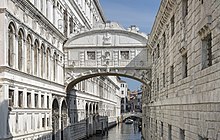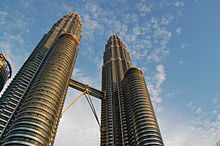Building bridge

A building bridge (also skyway , walkway , skybridge or building connection bridge ) is an above-ground pedestrian overpass or footbridge between two buildings or two building parts , within a large interior - for example in a factory hall or in the covered atrium of a hotel - and occasionally as a network in a larger building complex . If the building bridge is arched at the bottom, it is also called a connecting arch .
The definition of the terms is not clear, they are used depending on the local language, often as a marketing term in the real estate or tourism industry. The term Skywalk rather describes a viewing platform, such as the Grand Canyon Skywalk or Dachstein Skywalk . However, this term is also occasionally used for the function described above, as in the Skywalk (Hanover) .
function
The components are part of the horizontal development . They are often designed to be closed with respect to the environment and are then themselves an interior space . You can walk from one building to the other without being exposed to the weather or having to prove access authorization to a porter . They enable a comfortable and safe transition from one building to another.
If two buildings have different storey heights or are on a slope, the connecting bridges also have to compensate for height differences between the different floor levels.
They often span traffic routes such as streets or rivers, mostly just above the clear space required for traffic . Advantages result from the reduction in the risk of accidents and fewer harmful emissions (through an improved traffic flow ). In addition, the accessibility is improved, since stairs can be saved.
In addition to the development function, the components also serve as viewing platforms due to their exposed location, such as the "skybridge" of the Petronas Towers . These are usually steel structures.
Areas of application
- Between an existing building and its extension.
- Between two existing buildings that are to be shared. Such retrofitted skywalks often differ in their architectural language from the design of the existing buildings.
- In multi-storey, atrium-like lobbies of hotels or office buildings. Here they enable special spatial experiences.
- In traffic structures ( airport , train station ) where traffic arteries and pedestrian streams cross.
Examples
Skywalk in Beijing
New Town Hall , Leipzig
Networks
In the inner cities of North American cities in particular, entire networks of skyways have emerged that connect several blocks with one another. These paths are not public spaces, but close at night, comparable to the passages and squares in shopping malls . The world's largest interconnected skyway systems are located in Minneapolis , Minnesota and Calgary , Alberta . The Minneapolis Skyway System connects 69 blocks of downtown downtown over a distance of 8 miles. The Calgary network, called Plus 15 or +15 , covers a total of around 18 kilometers. These networks are partially supplemented by tunnels, which also connect buildings underground and thus result in a hybrid form with the underground cities.
Places with Skywalk networks (selection): Atlanta , Bangkok , Calgary , Cedar Rapids (Iowa) , Cincinnati , City of London , Des Moines , Detroit , Duluth (Minnesota) , Edmonton , Hong Kong , Houston , Minneapolis , Pittsburgh , Rochester (Minnesota ) Rochester (New York) , Saint John (New Brunswick) , Saint Paul (Minnesota) , Sioux City , Spokane (Washington) , Winnipeg .
Disasters
In the disaster at the Hyatt Regency Kansas City in Kansas City on July 17, 1981, two of the three skywalks in the hotel collapsed due to construction defects. It was the biggest collapse in the United States to date. 114 people died in the accident, three of them later in hospitals, and 216 people were injured, some seriously.
Web links
- Klaus Idelberger: Bridges between buildings. DBZ archive














